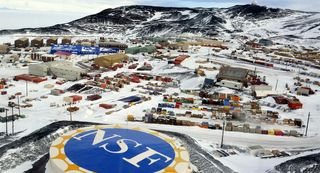
SpaceX's Starlink internet constellation is getting a serious remote-service test.
SpaceX has long touted Starlink's potential as a world connector, allowing people in rural areas and other underserved communities to access high-speed internet. And Starlink broadband is now beaming into one of the most remote communities on Earth — McMurdo Station, a research outpost run by the United States Antarctic Program (USAP).
"NSF-supported USAP scientists in #Antarctica are over the moon! Starlink is testing polar service with a newly deployed user terminal at McMurdo Station, increasing bandwidth and connectivity for science support," the U.S. National Science Foundation said via Twitter on Wednesday (Sept. 14).
Related: SpaceX's Starlink megaconstellation launches in photos
NSF-supported USAP scientists in #Antarctica are over the moon! Starlink is testing polar service with a newly deployed user terminal at McMurdo Station, increasing bandwidth and connectivity for science support. pic.twitter.com/c3kLGk8XBVSeptember 14, 2022
SpaceX celebrated the milestone as well. "Starlink is now on all seven continents! In such a remote location like Antarctica, this capability is enabled by Starlink's space laser network," the company tweeted on Wednesday.
SpaceX has already launched more than 3,200 Starlink satellites to low Earth orbit. And the constellation will grow to even more enormous proportions, if all goes according to plan: SpaceX has permission to loft 12,000 Starlink spacecraft, and the company has applied for permission from an international regulator to orbit 30,000 more satellites on top of that.
Starting next year, SpaceX plans to begin launching Starlink Version 2 satellites, which are much larger and more capable than the current iteration. Those next-gen spacecraft will be able to beam service directly to smartphones, SpaceX founder and CEO Elon Musk has said.
Get the Space.com Newsletter
Breaking space news, the latest updates on rocket launches, skywatching events and more!
Indeed, late last month, Musk announced that SpaceX and T-Mobile had signed a deal to provide such service, via a project called "Coverage Above and Beyond."
Starlink is crucial to SpaceX's long-term exploration goals. Musk has said that revenues from the broadband constellation are helping to fund Starship, the giant rocket-spaceship combo that SpaceX is developing to take people and cargo to the moon and Mars. SpaceX also plans to launch Starlink Version 2 satellites to orbit using Starship.
Mike Wall is the author of "Out There" (Grand Central Publishing, 2018; illustrated by Karl Tate), a book about the search for alien life. Follow him on Twitter @michaeldwall. Follow us on Twitter @Spacedotcom or on Facebook.
Join our Space Forums to keep talking space on the latest missions, night sky and more! And if you have a news tip, correction or comment, let us know at: community@space.com.

Michael Wall is a Senior Space Writer with Space.com and joined the team in 2010. He primarily covers exoplanets, spaceflight and military space, but has been known to dabble in the space art beat. His book about the search for alien life, "Out There," was published on Nov. 13, 2018. Before becoming a science writer, Michael worked as a herpetologist and wildlife biologist. He has a Ph.D. in evolutionary biology from the University of Sydney, Australia, a bachelor's degree from the University of Arizona, and a graduate certificate in science writing from the University of California, Santa Cruz. To find out what his latest project is, you can follow Michael on Twitter.
